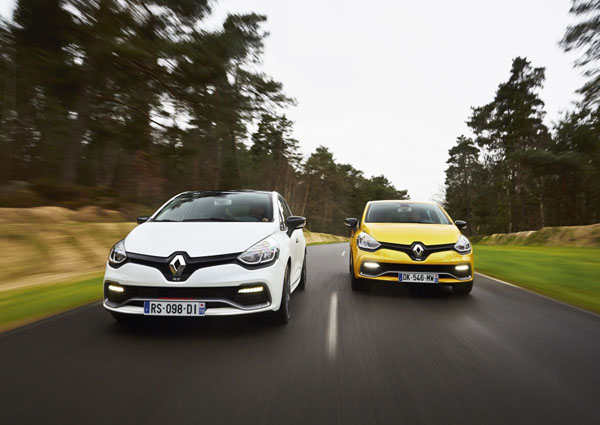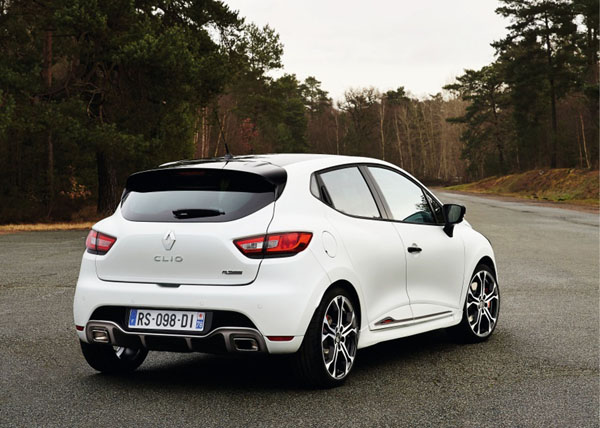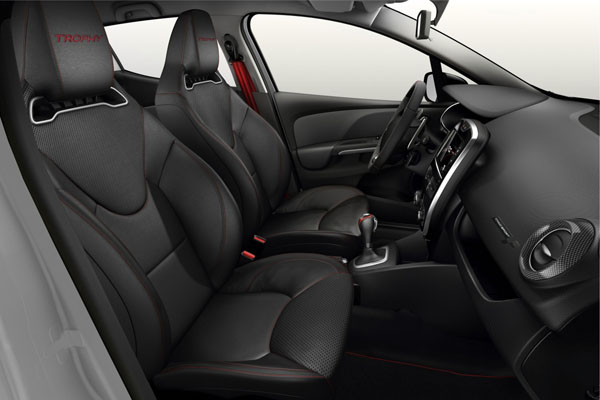Horses for courses: it’s a throwaway line to explain something that doesn’t quite fit. The Renault Clio RS 220 Trophy is a case in point. With its added ‘horses’ – power, that is – the special edition is not always at home on the street.
Compared with the Clio RS 200 EDC five-door hot hatch, the new limited edition features a more powerful engine with 15 extra kilowatts, up to 40 Newton metres more torque, a sportier chassis and an enhanced EDC (Efficient Dual Clutch) automatic transmission.
The Clio RS 220 EDC Trophy – 220 is its horsepower output – comes with new design 18-inch wheels, carbon-look interior trim details and leather sports seats with integrated head rests and is available in a new body colour, Frost White matte finish with exclusive gloss black roof.
Cleverly from a rarity point of view just 220 220 EDCs are being imported to Australia, priced at $39,990, plus on-road costs.
STYLING
Design features that differentiate the limited edition from its siblings include 18-inch diamond cut Radicale wheels and Trophy badging on the front spoiler, door trims and individually numbered door sills.
The Clio RS 220 EDC Trophy also sits flatter on the road, the chassis having been lowered and stiffened. It now squats 20 mm lower at the front and 10 mm lower at the rear unladen. Stiffer dampers have been fitted and are coupled with hydraulic bump stops.
INTERIOR
The cabin is kitted out with an embossed leather trim steering wheel, heated leather sports seats with integrated head rests and a gear lever base plate and air-vent inserts finished in satin-effect chrome instead of the anodised red in the standard Clio RS 200.
The gloss black centre console sports satin red inserts housing the 7.0-inch touch-screen navigation system, while the dashboard itself is made from prestigious soft-touch carbon with a Renault Sport logo inset.
The RS-badged steering wheel is wrapped in leather with sporty double red stitching. The seats are covered in dark carbon cloth upholstery and the RenaultSport logo on the headrests.
INFOTAINMENT
Driving performance information is carried over from the Clio RS 200 EDC with the latest on-board telemetry showing real-time driving data, including torque and power outputs, G-force diagrams, wheel traction figures, efficiency and much more on the 7.0-inch touch-screen.
The system can save driving data on USB which can be uploaded directly to the driver’s account on the RenaultSport.com website. On the site, stats and laps can be replayed and analysed to create public or private communities with fellow enthusiasts.
Using the mapping functions local courses can be created and shared with other driving enthusiasts via social media. Feel free to play with the R-Sound which replicates the engine notes of various vehicles including a motorbike, electric car and, yes, the Clio RS 220 EDC Trophy.
ENGINES / TRANSMISSIONS
Compared with the Clio RS 200 EDC, the 1.6-litre engine of the limited-edition version has 10 per cent more power and up to 40 Nm of extra torque thanks to new engine mapping, a larger turbo, an intake system designed to minimise back pressure losses and a revised exhaust system to accommodate a Euro 6 catalytic converter. Added torque is available thanks to a ‘torque boost’ function in fourth and fifth gears.
The vehicle’s EDC (Efficient Dual Clutch) transmission has been revised to achieve gear changes that are up to 30 per cent faster, with down changes made more rapid by reduced steering wheel shift paddle travel. There is now greater flexibility in ‘Sport’ mode to combine city and country driving.
SAFETY
Passive safety includes driver and front passenger airbags, plus driver and front passenger head and chest side airbag. The car features the latest in anti-lock braking with emergency brake assist, electronic brake-force distribution and emergency warning lights, which are activated under heavy braking.
Also incorporated are electronic stability control, anti-slip regulation and hill start assist. Surely the latter isn’t needed by any ‘real’ driver, indeed by anyone driving a car with an automatic transmission?
DRIVING
The test vehicle was finished in a vivid Liquid Yellow, which meant there was no hiding on pulling up to park, the colour attracting some enthusiastic comments.
Driving was accompanied by a surprisingly deep-throated note redolent of a larger capacity engine.
Stop / start technology is standard on the limited edition vehicle, marking the first time in Australia Renault has offered this feature in combination with the EDC transmission. The engine start-up from rest was a touch tardy, causing the car to lurch into action. A flick of a switch soon turned it off.
Column-mounted paddle shifters, which we are told is out of Renault’s development of Formula One race cars, allows greater speed and control over gear shifts, while a faster rack is designed to make steering even more precise and direct.
Handling of the test car was faultless. However, the same cannot be said of the ride, which due to extra-low profile tyres and stiffer suspension, picked up the smallest blemish in the road.
Uneven surfaces had the car rocking and rolling, while pot holes put the occupants through a thorough shaking, resulting in a chorus of protest.
Brakes had the power to pull up the car from high speed but in stop / start town traffic had a tendency to be grabby unless treated with consistent foot pedal pressure.
SUMMING UP
Australia is a happy hunting ground for Renault, being the second biggest market globally for the current Clio RS with more than 1400 sold since its 2013 launch. In that case, the Trophy hotter hatch could be racing ‘off the shelf’.
AT A GLANCE
MODEL RANGE
Renault Clio RS 200 Sport EDC automatic $29,990
Renault Clio RS 200 Cup EDC automatic $33,990
Renault Clio RS 200 Sport Premium EDC automatic $35,990
Renault Clio RS 200 Cup Premium EDC automatic $38,990
Renault Clio RS 220 EDC Trophy automatic $39,990
Note: These prices do not include government or dealer delivery charges. Contact your local Renault dealer for drive-away prices.
FEATURES
Driver and front passenger airbags
Driver and front passenger head and chest side airbag
Anti-lock Braking System with Emergency Brake Assist, Emergency warning lights activated under heavy braking, Electronic Brake-force Distribution
Electronic Stability Control
Anti-Slip Regulation
Hill Start Assist
LED daytime running lights mounted in front bumper
Rear fog light
Manual height adjustable headlights
Rear parking sensors
Rear view camera
Day and night rear view mirror
RS Drive with three modes – Normal, Sport or Race (ESC is disabled in race mode)
RS electronic LSD
Hands-free entry and engine start
Climate control air conditioning
Digital speedometer
4-speaker, 2-tweeter audio system by Arkamys with 3-D sound, AM/FM, MP3, auxiliary and USB input with fingertip controls
Renault Bass Reflex system
SPECIFICATIONS (Renault Clio RS 220 EDC 1.6-litre turbocharged petrol five-door hatchback)
ENGINE:
Capacity: 1.618 litres
Configuration: Four cylinders in line
Maximum Power: 162 kW @ 6000 rpm
Maximum Torque: 280 Nm @ 1750 rpm
Fuel Type: Petrol 95 RON (98 recommended)
Combined Fuel Cycle (ADR 81/02): 6.3 L/100km
CO2 Emissions: 144 g/km
DRIVELINE: Six-speed EDC automatic
DIMENSIONS, WEIGHT AND CAPACITIES:
Length: 4090 mm
Wheelbase: 2589 mm
Width: 1732 mm
Height: 1448 mm
Turning Circle: 10.9 metres
Kerb Mass: 1218 kg
Fuel Tank Capacity: 45 litres
BRAKES:
Front: Ventilated disc
Rear: Solid disc
STANDARD WARRANTY:
Five years / unlimited kilometres











